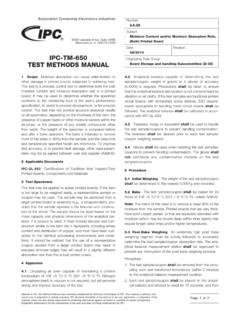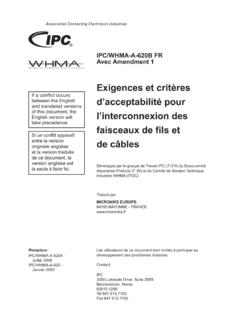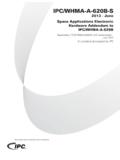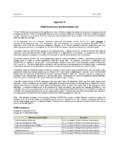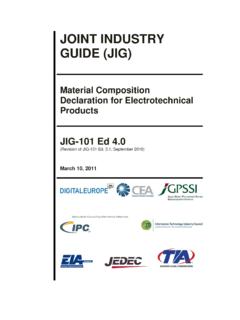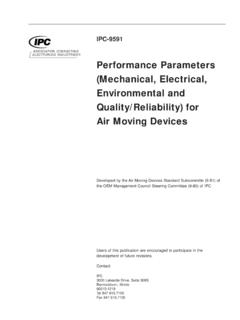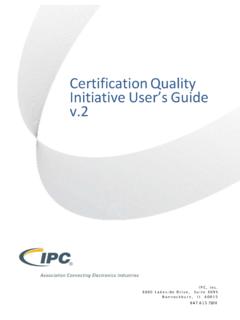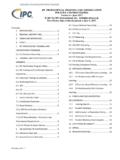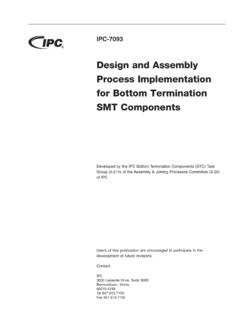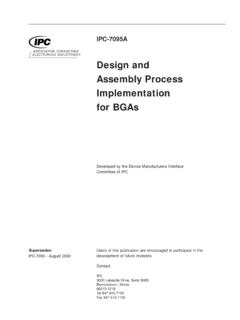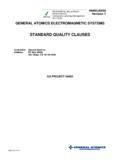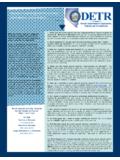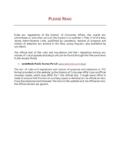Transcription of Documentation Requirements for Printed Boards, …
1 IPC-D-325 ADocumentation Requirementsfor Printed Boards, Assembliesand Support DrawingsIPC-D-325 AMay 1995 Original PublicationJanuary 1987 The Institute forInterconnectingand PackagingElectronic CircuitsA standard developed by the Institute for Interconnectingand Packaging Electronic Circuits2215 Sanders RoadNorthbrook, Illinois60062-6135 TelFaxURL:847 of .. shall .. Military Application .. of APPLICABLE for Interconnecting and PackagingElectronic of Defense .. and Sizes and Format .. and Drawing Number/Bare board Master Drawing Revision Level/Bare BoardRevision Level .. Revision Temporary Revision (Optional).. Updated and/or Redrawn Drawings .. Contract Application Block (Optional) .. Commercial and Government Entity(Cage Code).. Distribution Key (Optional).. Material Block (Optional).. Configuration Control .. Numbering of Documentation and Electronic.
2 SAMPLE FIGURES AND MASTER DRAWING NOTES ANDCHECK of Typical Notes:.. Drawing Check DESIGN Documentation Package .. System Printed board ASSEMBLY Drawing Definition .. / Group board Assembly Assembly Drawing Notes .. List (PL) Definition .. Parts Parts (Find) Component Cross Revision Level Control (RLC) Chart(Optional).. Component Locations Chart(Optional).. Cover Sheets (Optional).. Parts Non-Standard Part Manufacturing Tools Chart (Optional).. Electrostatic Sensitive Devices (ESD) .. Quality Conformance Printed board SUPPORT SCHEMATIC/LOGIC Scope .. Definition Schematic Reference Line Styles and Graphic Symbols and Cell Abbreviations and 76 IPC-D-325 AMay Connecting Terminals .. Wire Leads .. Interrupted Paths .. Mechanical Numerical Values.
3 Multi-Element Symbols .. Functions .. Reference Type Unused Gnd and Power Notes on Schematic/Logic Final 79 Appendix 80 Appendix 82 TablesTable 3 1 .. 6 Table 4 1 Typical Master Drawing DocumentationRequirements .. 14 Table 4 2 Typical Master Drawing Detail 15 Table 4 3 Drill Size 24 Table A 1 Geometric Characteristic Symbolsand 82 Table A 2 82 FiguresFigure 3 1 Artwork Configuration Control (Option I) .. 7 Figure 3 2 Artwork Configuration Control (Option II).. 8 Figure 3 3 Artwork Configuration Control (Option III).. 9 Figure 3 4 Title Block .. 10 Figure 3 5 Continuation Sheet and 11 Figure 3 6 Sign-off Column & Revision Status of 11 Figure 3 7 Temporary Revision 12 Figure 4 1 Graphical Representation Illustrating Artwork -Master Drawing 16 Figure 4 2 Printed Wiring board - 17 Figure 4 3 Electrostatic Discharge Symbol .. 18 Figure 4 4 board Cross Section - Six Layer 20 Figure 4 4A Example of Typical Cross-SectionDetail, mm [in].
4 21 Figure 4 4B Symmetrical Multilayer Printed BoardCross-Section Illustrating 21 Figure 4 5 Artwork Configuration Control Chart,Double-Sided board .. 22 Figure 4 6 Artwork Configuration Control Chart,6 Layer 22 Figure 4 7 Typical Hole 23 Figure 4 8 Drill Pattern Viewed from Primary Side, Layer 1,Scale 1 25 Figure 4 9 Printed board Profile ( board OutlineDimensioning), Example 26 Figure 4 9A Printed board Profile ( board OutlineDimensioning), Example 27 Figure 4 10 Example of Quality Conformance Coupons perIPC-D-275, 28 Figure 4 11 Advantages of Positional Tolerance Over BilateralTolerance, mm [in] .. 28 Figure 4 12 Example of Location of a Pattern of ToolingMounting Holes, mm [in].. 29 Figure 4 13 Example of Location of a Pattern ofPlated-Through Holes, mm [in] .. 29 Figure 4 14 Example of Location of a Conductor Pattern UsingFiducials, mm [in] .. 30 Figure 4 15 Example of Printed board Profile Location andTolerance, mm [in].
5 30 Figure 4 16 Example of a Printed board Drawing UtilizingGeometric Dimensioning andTolerancing, mm [in].. 31 Figure 5 1 Typical Multilayer Master Drawing,Sheet 1 of 5 .. 32 Figure 5 1 Typical Multilayer Master Drawing,Sheet 2 of 5 .. 33 Figure 5 1 Typical Multilayer Master Drawing,Sheet 3 of 5.. 34 Figure 5 1 Typical Multilayer Master Drawing,Sheet 4 of 5 .. 35 Figure 5 1 Typical Multilayer Master Drawing,Sheet 5 of 5 .. 36 May 1995 IPC-D-325 AivFigure 5 2 Typical SMT Printed board , Panelized and Routedfor Break-Apart Use (Refer to IPC-D-322).. 37 Figure 5 3 Typical Multilayer Master Drawing with ExternalHeatsink, Sheet 1 of 38 Figure 5 3 Typical Multilayer Master Drawing with ExternalHeatsink, Sheet 2 of 39 Figure 5 3 Typical Multilayer Master Drawing with ExternalHeatsink, Sheet 3 of 40 Figure 5 3 Typical Multilayer Master Drawing with ExternalHeatsink, Sheet 4 of 41 Figure 5 3 Typical Multilayer Master Drawing with ExternalHeatsink, Sheet 5 of 42 Figure 5 3 Typical Multilayer Master Drawing with ExternalHeatsink, Sheet 6 of 43 Figure 5 3 Typical Multilayer Master Drawing with ExternalHeatsink, Sheet 7 of 44 Figure 5 3 Typical Multilayer Master Drawing with ExternalHeatsink, Sheet 8 of 45 Figure 5 3 Typical Multilayer Master Drawing with ExternalHeatsink, Sheet 9 of 46 Figure 5 3 Typical Multilayer Master Drawing with ExternalHeatsink, Sheet 10 of 47 Figure 5 3 Typical Multilayer Master Drawing with ExternalHeatsink.
6 Sheet 11 of 48 Figure 5 3 Typical Multilayer Master Drawing with ExternalHeatsink, Sheet 12 of 49 Figure 5 3 Typical Multilayer Master Drawing with ExternalHeatsink, Sheet 13 of 50 Figure 5 3 Typical Multilayer Master Drawing with ExternalHeatsink, Sheet 14 of 51 Figure 7 1 Typical 55 Figure 8 1 Typical Printed Wiring Assembly 58 Figure 8 1A Typical PWB Assembly Marking 59 Figure 8 1B Typical PWB Assembly Marking 59 Figure 8 2 Typical Parts List for a PWB Assembly,Sheet 1 of 8 .. 60 Figure 8 2 Typical Parts List for a PWB Assembly,Sheet 2 of 8 .. 61 Figure 8 2 Typical Parts List for a PWB Assembly,Sheet 3 of 8 .. 62 Figure 8 2 Typical Parts List for a PWB Assembly,Sheet 4 of 8 .. 63 Figure 8 2 Typical Parts List for a PWB Assembly,Sheet 5 of 8 .. 64 Figure 8 2 Typical Parts List for a PWB Assembly,Sheet 6 of 8 .. 65 Figure 8 2 Typical Parts List for a PWB Assembly,Sheet 7 of 8 .. 66 Figure 8 2 Typical Parts List for a PWB Assembly,Sheet 8 of 8.
7 67 Figure 8 3 Typical Through-Hole Printed Wiring AssemblyDrawing, Sheet 1 of 68 Figure 8 3 Typical Through-Hole Printed Wiring AssemblyDrawing, Sheet 2 of 69 Figure 8 4 Typical SMT Assembly with Components onTwo 70 Figure 8 5 Electrostatic Discharge Symbol .. 71 Figure 9 1 Typical Backing Plate Assembly Used to SupportPrinted board During Press-Fit 72 Figure 9 2 Typical Printed board Assembly 72 Figure 9 3 Printed board Assembly Illustrating Typical FrontPanel and Ejector 72 Figure 9 4 Typical Heatsink 73 Figure 9 5 Typical Stiffener 74 Figure 9 6 Typical Heatsink Bracket .. 75 Figure 10 1 Connecting Line 77 Figure 10 2 Switch/Relay 77 Figure 10 3 Wire Leaded Components .. 77 Figure 10 4 Interrupted 77 Figure 10 6 Connectors .. 78 Figure 10 5 Switches/Relays .. 78 Figure 10 7 78 Figure 10 8 Unused Pins .. 79 Figure A 1 Feature control frame incorporatingdatum 82 Figure A 2 Feature control frame .. 82 Figure A 3 Order of precedence of datum 82 IPC-D-325 AMay 1995vDocumentation Requirements for Printed Boards, assemblies and Support SCOPEThis standard establishes Requirements and other consider-ations for the Documentation of Printed boards and printedboard PurposeThe purpose of this standard is to establishthe general Requirements for the preparation of drawingsnecessary to fully describe end product Printed Boards, Printed board assemblies and related support emphasis is given to the technical requirementsnecessary to fully describe the fabrication and assembly ofvarious types of Printed boards.
8 Regardless of material,construction, layer count, special fabrication Requirements ,or end product usage, the Documentation package mayinclude, but not be limited to the following: Master Drawing Requirements Specifications board Definition Artwork/Phototooling Soldermask Requirements Master Pattern Drawing Production Master Assembly Drawing and Parts List Electrical Test Requirements Final Schematic/Logic Diagram Related Support Drawings Artwork Plot Data Excellon Drill DataRefer to IPC-D-275, Design Standard for Rigid PrintedBoards and Rigid Printed board assemblies , regarding allsubjects pertaining directly to standard may be used for both commercial and mili-tary applications. Printed boards and Printed board assem-blies intended for military usageshallbe fabricated and/orassembled by a manufacturer that has been qualified to theappropriate military specification, unless otherwise agreedto intended for military electronic equipmentshallbe so Organization of InformationThis standard is orga-nized into various sections in order to provide informationfor the Documentation of rigid Printed boards and printedboard major sections and their specific emphasis are.
9 Section 1 Scope, Purpose and ClassificationSection 2 Applicable DocumentsSection 3 Documentation RequirementsSection 4 Documentation PackageSection 5 Sample Figures and ExamplesSection 6 Master Drawing Notes and Check ListSection 7 Design OutputsSection 8 Printed board Assembly Drawings(Including Figures & Examples)Section 9 Printed board Support DrawingsSection 10 Schematic / Logic ClassificationThis standard recognizes that rigidprinted boards and Printed board assemblies are subject toclassifications by intended end item use. Classification ofproducibility is related to complexity of the design and theprecision required to produce the particular Printed boardor Printed board producibility level or producibility design characteris-tic may be applied to any end-product equipment , a high-reliability product designated as class 3 (see ), could require level A design complexity(preferred producibility) for many of the attributes of theprinted board or Printed board assembly (see ).
10 board TypesThis standard provides design infor-mation for different board types. board types are classified:Type 1 Single-Sided Printed BoardType 2 Double-Sided Printed BoardType 3 Multilayer board without Blind orBuried ViasType 4 Multilayer board with Blind and/orBuried ViasType 5 Multilayer Metal-Core board withoutBlind or Buried ViasType 6 Multilayer Metal-Core board with Blindand/or Buried Performance ClassesThree general end-productclasses have been established to reflect progressiveincreases in sophistication, functional performance require-ments and testing/inspection frequency. It should be recog-nized that there may be an overlap of equipment 1995 IPC-D-325A1 The Printed board user is responsible for determining theclass in which his board product 1 General Electronic ProductsIncludes consumer products, some computer and computerperipherals, as well as general military hardware suitablefor applications where cosmetic imperfections are notimportant and the major requirement is function of thecompleted Printed board or Printed board 2 Dedicated Service Electronic ProductsIncludes communications equipment, sophisticated busi-ness machines, instruments and military equipment wherehigh performance and extended life is required, and forwhich uninterrupted service is desired but is not cosmetic imperfections are 3 High Reliability Electronic ProductsIncludes the equipment for commercial and military prod-ucts where continued performance or performance ondemand is critical.
